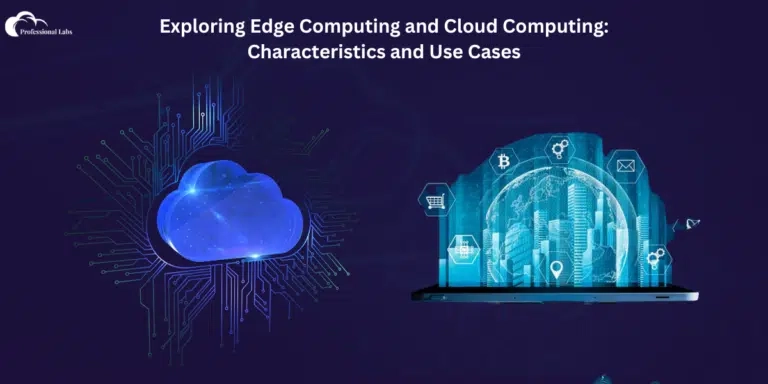- Home
- About
- Services
- Custom Software Development Services
- Managed SOC Security Service
- Azure Virtual Desktop Service
- Defender For Endpoint Technologies To Safeguard Networks
- Cloud Managed Services
- Email Security Services Provider
- Expert Citrix Consulting Services
- IT Help Desk
- PKI Consulting
- Microsoft Cloud App Security Services
- Microsoft Defender For Identity Security Services
- Market Research Services
- Modern Workplace
- Web Development Services
- Active Directory Consulting
- Azure Cloud Managed Security Services
- IT Training Services
Support and Market Research
- Partnership
- Blog
- Contact
Exploring Edge Computing and Cloud Computing: Characteristics and Use Cases

Cloud Computing and Edge Computing are two different ways of handling data and running programs. Cloud Computing uses faraway servers connected to the internet. These servers store data, run programs, and offer services whenever you need them.
On the other hand, Edge Computing brings processing power closer to where data is created. Instead of sending all data far away to big data centers, Edge Computing processes it nearby, where devices like sensors produce it. This makes things faster because data doesn’t have to travel far. It’s great for applications that need quick responses, like IoT, self-driving cars, and making factories more efficient. Edge Computing makes everything work smoothly and fast.
Key characteristics of Cloud Computing:
- Centralized Infrastructure: Cloud Computing depends on centralized data centers which located in remote locations. These data centers host vast amounts of data and applications that users can access through the internet.
- Scalability: Cloud services can easily scale up or down based on demand, allowing businesses to adjust resources dynamically without the need for physical upgrades.
- Accessibility: Cloud services are accessible from anywhere with an internet connection, enabling remote access to data and applications on various devices.
Edge Computing:
Edge Computing involves processing data near the source of generation. It brings computation and data storage closer to the devices and sensors that produce the data, reducing latency and enabling real-time processing and analysis.
Key characteristics of Edge Computing:
- Decentralized Processing: Edge Computing distributes processing power to the edge of the network, enabling data processing and analysis closer to where it’s generated. This reduces the need to transmit large amounts of data to centralized servers, improving response times and efficiency.
- Low Latency: By processing data locally, Edge Computing minimizes latency, making it ideal for applications that require immediate responses, such as autonomous vehicles, industrial automation, and augmented reality.
- Bandwidth Efficiency: Edge Computing reduces the burden on network bandwidth by processing data locally, which is particularly beneficial in environments with limited connectivity or high volumes of data.
Key Differences:
- Location of Processing: Cloud Computing processes data in centralized data centers, whereas Edge Computing processes data at or near the source of generation.
- Latency: Edge Computing offers lower latency by processing data locally, while Cloud Computing may introduce delays due to data transmission to remote servers.
- Scalability vs. Efficiency: Cloud Computing prioritizes scalability and flexibility, whereas Edge Computing emphasizes efficiency and real-time processing.
Here are some practical ways Edge Computing is used:
Internet of Things (IoT): Edge Computing is crucial for IoT, where devices collect data in real-time. By processing this data locally, IoT devices can respond quickly and reduce the need for constant internet connection. For example, in smart homes, sensors can adjust temperature or lighting without relying on the cloud.
Autonomous Vehicles: Edge Computing is essential for self-driving cars. By analyzing sensor data within the vehicle, Edge Computing enables quick decision-making without waiting for data to be sent to remote servers. This ensures safe and reliable driving experiences.
Industrial Automation: Edge Computing revolutionizes manufacturing processes by analyzing data right on the factory floor. Machines equipped with edge devices can predict maintenance needs, ensure quality control, and optimize production without relying on continuous internet access.
Retail Analytics: Edge Computing enhances shopping experiences by analyzing customer behavior in real-time. By processing data locally, retailers can offer personalized recommendations and promotions without depending on cloud services. This improves customer satisfaction and boosts sales.
Cloud Computing is used in various ways to make tasks easier. Here are some examples:
Software as a Service (SaaS): Instead of buying software and installing it on your computer, Cloud Computing lets you use software over the internet. Companies that provide this service store the software on their servers, so you can access it from any device with internet. For example, programs like Google Workspace for writing documents or Salesforce for managing customer information.
Big Data Analytics: Cloud Computing helps process and understand large amounts of data. Businesses use special cloud-based tools to analyze big data, like information from many customers or sources. This helps them make smart decisions and predictions using data.
Content Delivery Networks (CDNs): Cloud Computing makes websites faster and more reliable. CDNs store website content on many servers around the world. When you visit a website, the CDN sends you content from the closest server, reducing waiting time. This makes websites load quicker and improves your browsing experience.
Edge Computing and Cloud Computing are two vital components of modern digital infrastructure. While Cloud Computing offers scalability and centralized processing, Edge Computing brings real-time analysis closer to data sources, reducing latency. Their combined capabilities enable organizations to innovate, enhance efficiency, and deliver value across diverse industries, forming a symbiotic relationship that drives the evolution of technology in our interconnected world.
Connect us and transform your business with our Cloud Computing services.

